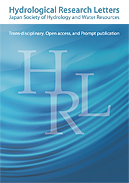In this study, we developed a distributed rainfall-runoff and sedimentation model based on one-dimensional kinematic wave equations. Physically-based rainfall-runoff and erosion-sediment processes were coupled and solved for each spatial grid, whilst the spatially distributed grids were connected to each other to allow for space-and-time movements of water and sediment. The model was applied to the Akatani River basin of the Chikugo River in Kyushu, Japan using a 10 m high-resolution digital elevation model and eXtended RAdar Information Network (XRAIN) data as a time-and-space distributed rainfall input of the northern Kyushu heavy rainfall event in July 2017. Our results indicate that the rainfall-runoff hydrograph and sediment flow results are in agreement with the collected field data, and elevation of the river bed after the disaster was successfully reproduced by applying a sediment theory to estimate river bed variation. In addition, we found that sediment transport results are sensitive to model spatial resolution. Our simulation model is intended for use with basins that feature steep slopes and are prone to erosion and shear strength reduction after heavy rainfall events. Hence, this model can be applied to give early warnings by identifying critical erosional areas during forecasted heavy rainfall events.
View full abstract
